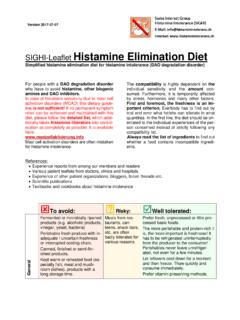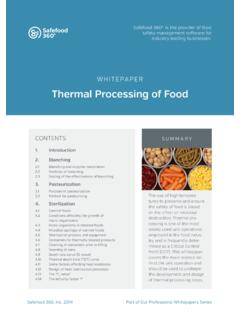Transcription of KIDNEY STONE & URINE ANALYSIS - KAZMIS HEALTH CARE …
1 Falling Hair Problems & Probable 12 January 2011 1 KIDNEY STONE & URINE ANALYSIS The Urinalysis: The urinalysis measures the presence and amount of a number of chemicals in the URINE , which reflect much about the HEALTH of the kidneys, along with cells that may be present in the URINE . We try to identify crystals, bacteria, yeast, red cells, white cells (indicating infection), something called a cast (which is a clump of sloughed cells from inside the tiny renal filtration tubules), sperm and even the occasional parasite. This lets us know if we are dealing with infection, diet or metabolism disorders, and what part of the urinary system is in trouble. Also, veterinarians or in human medicine the lab, looks for crystals, bacteria, and other organisms in the urinary sediment. Each of these elements give hints as to function of the kidneys, KIDNEY tubules, ureters (small tubes that connect the kidneys with the urinary bladder), and the urinary bladder.
2 The first part of a urinalysis is direct visual observation. Normal, fresh URINE is pale to dark yellow or amber in color and clear. Normal URINE volume is 750 to 2000 ml/24hr. Turbidity or cloudiness may be caused by excessive cellular material or protein in the URINE or may develop from crystallization or precipitation of salts upon standing at room temperature or in the refrigerator which is usually of no significance. Clearing of the specimen after addition of a small amount of acid indicates that precipitation of salts is the probable cause of turbidity. URINE is normally transparent in most animals, except for the horse. The horse has a thick viscous URINE that is cloudy on examination. In small animals, turbidity suggests the presence of cells, casts, or crystals. A red or red-brown (abnormal) color could be from a food dye, eating fresh beets, a drug, or the presence of either hemoglobin or myoglobin.
3 If the sample contained many red blood cells, it would be cloudy as well as red. URINE Odor: URINE has a characteristic smell that varies slightly by species and concentration of the sample. A particularly foul odor may occur in the presence of bacteria. Thus, strong smelling URINE is common in cases of cystitis. Ketonuria (ketones are produced when tissues are breaking down like in the process of starvation) produces a very sweet smell Falling Hair Problems & Probable 12 January 2011 2 as does Glucosuria (sugar in the URINE from diabetes). Sweet smelling URINE is commonly associated with acetonemia (acetones in the URINE ), pregnancy toxemia, and diabetes mellitus. Urinary Dip Stick Test: URINE tests are typically evaluated with a reagent strip that is briefly dipped into the URINE sample. The technician reads the colors of each test and compares them with a reference chart. Glucose (test for diabetes) Bilirubins (tests for liver disease and biliary obstructin) Ketones (tests for fat breakdown products, insulin deficiency, starvation) Specific gravity (to see if the KIDNEY is concentrating the URINE ) Blood (infection or irritation) pH (tells us what kinds of stones may be present if this is abnormal additional test gives more information) Protein (tests for integrity of the filtering system) Urobininogen Nitrites (a test for some bacterial infections) Leukocytes (White blood cells indicating infection or cancer) URINE Sediment: The URINE is then spun down and the sediment checked for cells, yeast, bacteria, crystals, and casts (groups of dead cells that indicate KIDNEY tubule damage).
4 We ll talk about those below. Here are some tips on collecting the URINE sample: If you are doing a free-catch sample, it is nice to have some URINE caught in the beginning, middle and end of the urination process. Why? The first fraction coming out flushes cells, yeast and bacteria from the vulva or prepuce areas and the urethra (the tube that connects the bladder to the outside world). The middle fraction is a better picture of what has been stored in the bladder. The tail-end of the sample gives a better idea of how the kidneys look. Falling Hair Problems & Probable 12 January 2011 3 My personal choice as a veterinarian is to stick a long needle directly into the bladder so I don't have to guess if the bacteria, yeast and dead cells are from the urethra or the bladder. It doesn't hurt much and helps alleviate contamination of the sample. That way I can treat the core cause instead of a secondary infection of some type.
5 Medical doctors sometimes insert a catheter into the bladder for this reason. If you are trying to get a sample from your pet at home, one easy way to do it is to tape a small cup to the bottom of the ruler. As the pet urinates, you can slip the cup underneath them without leaning over and startling them. Label the sample with the date and time it was collected then get the sample to your vet right away for testing. URINE Volume: Increased URINE Volume (Polyuria): Rule out acute renal disease, chronic renal disease, diabetes mellitus hepatic failure, hyperadrenoorticism, hypercalcemia, hyperparathyroidism (cats and humans), nephrogenic diabetes insipidus, pituitary diabetes insipidus, post obstructive diuresis, primary renal glyosuria, psychogenic polydipsia, pyelonephritis, and pyometra. Decreased URINE Volume (Oliguria): Rule out acute renal failure, dehydration, shock, terminal chronic renal disease, and urinary tract obstruction.
6 PH: pH is a measure of hydrogen ion concentration (acidity or alkalinity) of the URINE . Fresh samples are necessary for an accurate reading because URINE becomes alkaline when it is older because the carbon dioxide escapes and the bacteria in the URINE convert urea to ammonia which is very alkaline. The healthy, normal pH of human URINE is less than 7. The glomerular filtrate of blood plasma is usually acidified by renal tubules and collecting ducts from a pH of to about 6 in the final URINE . However, depending on the acid-base status, urinary pH may range from as low as to as high as The change to the acid side of is accomplished in the distal convoluted tubule and the collecting duct. For the crystals formed in acid, neutral or alkaline pH, see my handout under Urinary and KIDNEY stones . Urinary pH Too High (Alkaline): Rule out diets high in vegetables and urinary tract infections (the bacteria convert the URINE to ammonia).
7 Note: This is the only instance where I tell people to eat lots of protein and junk food for 2-3 days! Falling Hair Problems & Probable 12 January 2011 4 Urinary pH Too Low (Acid): Rule out diets high in protein and refined carbohydrates, anorexia, and starvation. Specific Gravity: (SG): This measures how dilute your URINE is. Specific gravity takes into account the weight of the URINE and particle size. Water would have a specific gravity of Specific gravity between and on a random sample should be considered normal if KIDNEY function is normal. Most human URINE is around , but it can vary greatly depending on when you drank fluids last, or if you are dehydrated. If the specific gravity is not > after a 12 hour period without food or water, renal concentrating ability is impaired and the patient either has generalized renal impairment or nephrogenic diabetes insipidus. In end-stage renal disease, specific gravity tends to become to Any URINE having a specific gravity over is either contaminated, contains very high levels of glucose, or the patient may have recently received high density radiopaque dyes intravenously for radiographic studies or low molecular weight dextran solutions.
8 Most laboratories measure specific gravity with a refractometer (see above picture). Glucose: Normally there is no glucose in URINE . Detectable Glucose (Glucosuria): Rule out diabetes mellitus, KIDNEY disease (decreased tubular reabsorption), acromegaly, hyperpituitarism, bovine milk fever, bovine neurologic disease, excessive insulin dosage, fear or exertional catecholamine release, Fanconi-like syndrome (which can be caused by taking expired tetracycline), moribund animals, sheep endotoxemia, and drugs such as ACTH, glucocorticoids, fluids, Ketamine, morphine, phenothiazine, and xylazine. A small number of people have glucose in their URINE with normal blood glucose levels, however any glucose in the URINE would raise the possibility of diabetes or glucose intolerance. Dipsticks employing the glucose oxidase reaction for screening are specific for glucose but can miss other reducing sugars such as galactose and fructose.
9 For this reason, most newborn and infant urines are routinely screened for reducing sugars by methods other than Falling Hair Problems & Probable 12 January 2011 5 glucose oxidase (such as the Clinitest, a modified Benedict's copper reduction test). I don t remember learning about these tests when I took clinical pathology in veterinary school. Protein (Proteinuria): When you urinate and see foam in the toilet bowl, this can indicate either sugar or protein and is not normal. A urinalysis and bloodwork are used to determine what the problem is. Talk with your doctor if you see this. Normally there is no protein detectable on a urinalysis strip. Detectable Protein in the URINE : Rule out KIDNEY damage, increased glomerular permeability (from fever, cardiac disease, central nervous system disease, shock, muscular exertion), blood in the URINE , inflammation, cancers, infection. High concentrations of very small proteins can also show up in the URINE such as Bence Jones protein (a sign of cancer), hemoglobin monomers, and myoglobin.
10 Up to 10% of children can have protein in their URINE . Sometimes this is due to colostral antibodies. Certain diseases require the use of a special, more sensitive (and more expensive) test for protein called a microalbumin test. A microalbumin test is very useful in screening for early damage to the kidneys from diabetes. False Positive causes: Rule out URINE too alkaline. Blood in the URINE (Hematuria): Normally there is no blood in the URINE . Detectable Blood in the URINE : Rule out infection, KIDNEY stones , trauma, and bleeding from bladder or KIDNEY tumors. The technician may indicate whether the blood is hemolyzed (dissolved blood) or non-hemolyzed (intact red blood cells). False Positive causes: Rarely, muscle injury can cause myoglobin to appear in the URINE which also causes the reagent pad to falsely indicate blood. Bilirubin in the URINE (Bilirubinuria): Normally there is no bilirubin or urobilinogen in the URINE .




